Horror
Let Me In // Let The Right One In
This is just a short and grumpy post.
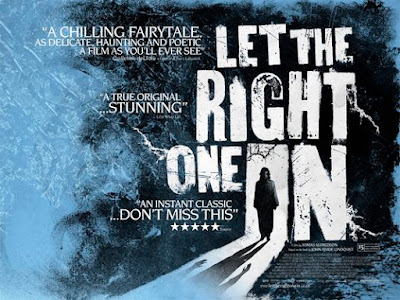
Let Me In. If you’ve been paying attention you’ll know that it’s the forthcoming remake of 2008’s (?) Let The Right One In, a Swedish film that is easily one of the best horror productions of recent years (maybe even the decade?) and an antidote to the sparkly fang-less prancing of the Twilight saga.
Matt Reeves, the director of the remake is reported in Empire as saying that he simply can’t understand the furore around the remake, claiming it should be normal as Hollywood has been churning out remakes for years. Quite apart from the fact that the “it’s happened lots of times before” argument is a completely pathetic method of avoiding the point entirely, he has also chosen to ignore that the remake culture he refers to is usually concerned with remaking films that are twenty or so years old. Not two.
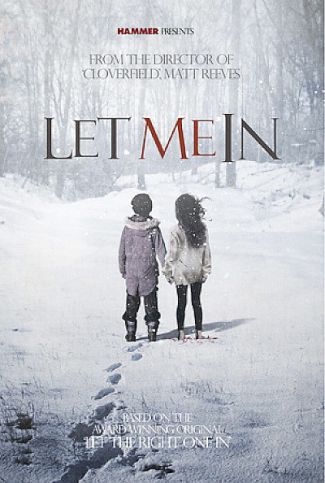
As an example, the remake of Nightmare on Elm Street, although completely unnecessary, is clearly catering to an entirely new audience, a younger generation who haven’t seen the original but are (perhaps unwittingly) just waiting to be shepherded in to the world of gory horror flicks.
Let Me In, however, is surely only really being made to cater to those who are too damn lazy to read subtitles. The recent Spanish zombie masterpiece [Rec] was given the same treatment and turned into Quarantine, a move almost universally condemned, and I really struggle to see how the situation will be any different here.
For anyone who’s read the (fantastic) original novel by John Ajvide Lindqvist, there is perhaps a glimmer of hope that they’ll go back to the text and pick out some of the interesting sub-plots that were stripped in the first transition from page to screen. This is surely the only thing which could justify a re-make. It is, however, pretty unlikely as Lindqvist wrote the screenplay for the original and hasn’t touched the new version (as far as I can see, anyway)
So, it’s fingers crossed hoping for increased faithfulness to the text, but I’m afraid I’m entirely sceptical. I’ll still watch it, but it’ll have to work twice as hard to convince me that it’s a worthwhile film.
Trailer for the original:
Hammer Horror - Dracula and Brides of Dracula
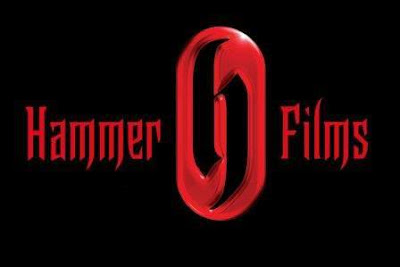
Part of the aim of writing this blog and of taking more notice of what I watch, is to improve my general film knowledge and to encourage me to fill in some of the gaps - whole genres and famous names that I know little or nothing about.
Sometime of course, fishing about in new genres just isn’t appealing and I’ll settle back into the safety of the Spaghetti Western or a predictably nonsense ‘horror’ film - like Attack of the Killer Shrews. Recent viewing however has seen me beginning to get to grips with classic American Film Noir (about which I’m sure I’ll write something soon) and, for this post, the wonderful world of Hammer Horror.
I’m not quite sure how on earth I’d gone for so long with very little awareness of Hammer’s output. As a firm fan of both Christopher Lee and Peter Cushing, with a fondness for slighly camp British horror of the last few decades, how had I never really become a Hammer fan?
Thankfully, I am now very much a Hammer fan. I bought A New Heritage of Horror by David Pirie (I.B.Tauris, £15) which, however much he tries to deny it in his introduction, is basically a history of Hammer’s film output. And none the worse for it. Much as my love of Zombie films was gently lead and guided by Jamie Russell’s Book of the Dead (Fab Press, £11), I found myself flicking through this book with a growing list of scribbled down “must-see” titles.
I started with X: The Unknown (radioactive slime crawls out from the centre of the planet and munches its way through some tasty radioactive things), Hound of the Baskevilles (Good fun adaptation) and The Devil Rides Out - which I enjoyed a lot and might have to re-watch and review)
My now fairly strong feeling that I was onto something rather wonderful was confirmed when I moved onto the Dracula series. So let’s start at the beginning shall we?
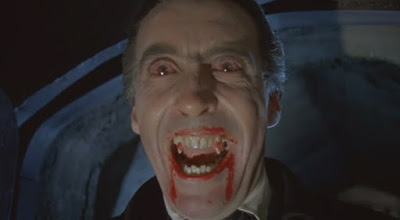
Hammer’s 1958 version of Dracula is brilliant. THere are flaws a plenty but I think it’d be hard not to enjoy the film. It’s well-paced, ever-so British and it has Christopher Lee draining the blood from those around him. What’s not to like?
It was one of Hammer’s first widescreen and colour production and really does look beautiful - although the colour of the blood is decidedly more akin to strawberry than it perhaps should be. Though obviously not being produced on a massive budget, the sets are wonderful, Dracula’s Transylvanian castle is as real as you could hope for and the whole film carries its gothic mood wonderfully.
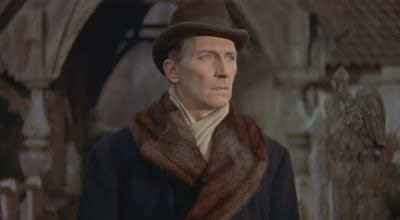
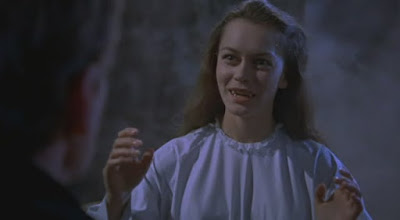
Budget constraints did force them to savage the plot somewhat (Johnathon Harker’s family now live er… right near the castle) and many elelments are missing but this doesn’t particularly hurt the film in itself. Whilst it might suffer in comparison to the novel, the story that remains is strong enough and moves along at a decent pace, aided no doubt by some brilliant acting. Christopher Lee is a perfect Dracula; just the right balance of menace, charm and pointy-teeth, whilst Cushing is brilliant in the somewhat more understated part of Van Helsing.
The film was one of Hammer’s biggest successes and sold well the world over….
….So they made some more.
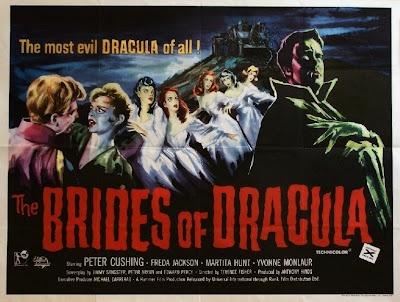
Needless to say, Hammer quickly realised that having Dracula destroyed at the end of the first film wasn’t really the smartest move - they needed more vampire and they needed it now! Similarly awkward was Christopher Lee’s absence; David Pirie writes that it’s unknown whether he flat-out refused or asked for more money than Hammer could spend. Either way, he wasn’t coming back. So neither was Dracula.
Infact, the follow-up to Dracula, 1960’s The Brides of Dracula is pretty surprising as a Dracula film for er…. not having Dracula in it.
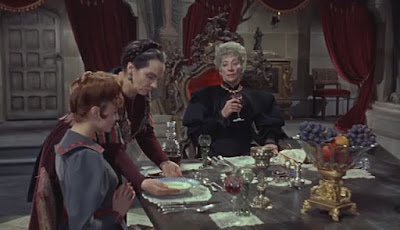
It’s still pretty good fun; Cushing returns as Van Helsing who really does just happen to be in the right place at the right time all over again and is on hand to help stop the rise of the Baron Meinster who has escaped from his perpetual confinement and has gone on a bit of a rampage, sinking his teeth into the necks of the women he meets.
It’s another good fun film, although there’s decidedly less tension to it - despite the fact that I didn’t already know the story, this Baron was so much less charismatic, so much less calm and cool, that I really did struggle to imagine him winning. Needless to say, he doesn’t.
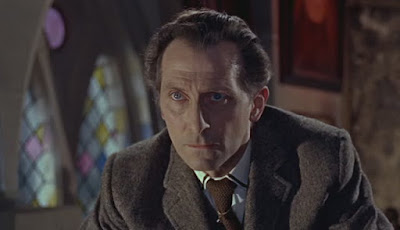
What it loses in tension and atmosphere -especially in the second half - however, it does mostly make up for by being generally a lot of fun. And we like fun films, right?
Of course we do.
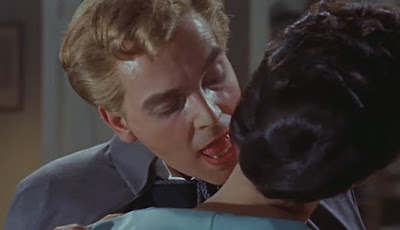
Microwave Massacre
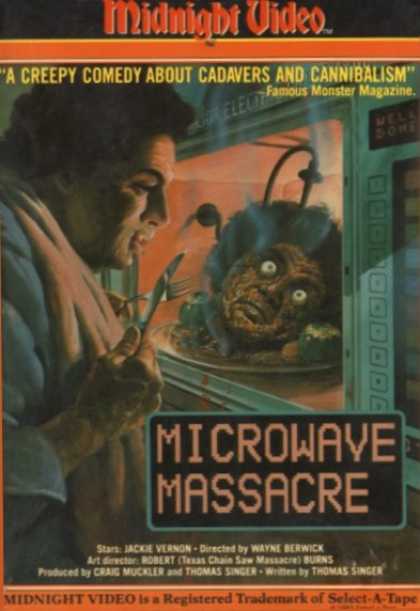
Oh dear, here we go again. I definitely don’t plan to make this the norm, but I’m afraid that this is my second spoiler filled post. I think I can justify it again though. With Underwater City, I didn’t feel to bad about giving spoilers as 1)You will probably never see it 2)If the opportunity does arise, you should probably turn it down. Forewarned is forearmed, afterall, and Underwater City isn’t a particularly attractive prospect.
Here, it’s a somewhat different case, as Microwave Massacre is really an awful lot of fun. I think I can still get away with spoilers though as 1)You will probably never see it (it’s out-of-print, though copies are floating around on ebay) and 2)Knowing what happens really won’t spoil your enjoyment of this great-fun low-budget cannibalistic slasher.
So here we go. This post will be somewhat heavier on pictures than words as they really do most of the talking for themselves. Infact, this is less of a review than just telling the story. I’m sorry. But I can promise that telling the story will make you want to watch it far more than a review ever could!
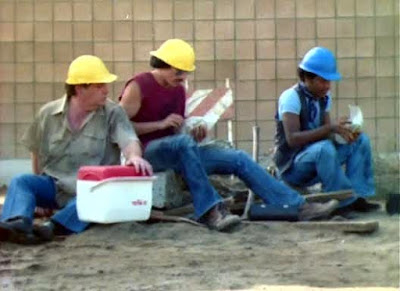
The story revolves around Donald, a middle-aged construction worker. Poor Donald is just an average guy really; he likes the simple things - he works, he has a beer and then he goes home to his wife for some good ol’ home-cooked American food. Except, just his wife, since buying a super new microwave only wants to cook exotic foreign dishes. Stand-up rows over “food you can’t pronounce” ensue and Donald gets more and more miserable.
So far, so normal. At this stage the film really is showing very little promise. The dialogue is clunky to say the least and nothing much is happening. Donald’s exchanges with his (younger, hipper) co-workers are fairly funny but nothing much to shout about. They do slip in a brilliant visual gag though… as Donald’s work-mates get out their humble foil-wrapped sandwhiches, Donald fishes in his cool-box for the lunch his wife has prepared him: an entire crab in a massive bap!
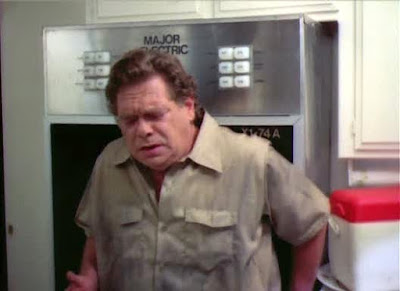
With tension rising, you just know something’s going to break, and break it does. After getting perhaps a little too drunk, Donald returns home in a rage and drunkenly kills his wife. Whoops.
At this point the movie is still distinctly so-so. We’re a good chunk through and there’s no hint of a massacre, the microwave is only lurking in the corner and you could perhaps feel a little cheated. But persevere! as things are about to get a whole lot better.
Being a little bit inexperienced at this murdering lark, Donald cuts her up into pieces, sticks her in the fridge and is content to forget about her for a bit.
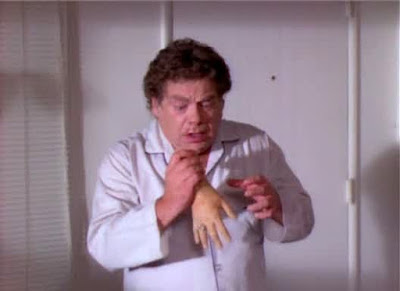
Completely by accident however, Donald mixes up the left-over food from the fridge and finds himself munching on a piece of his late wife. Even more surprising is that she tastes pretty good! Once over his initial revulsion, Donald tucks in quite happily and soon begins eating her for every meal …. including lunch at work.
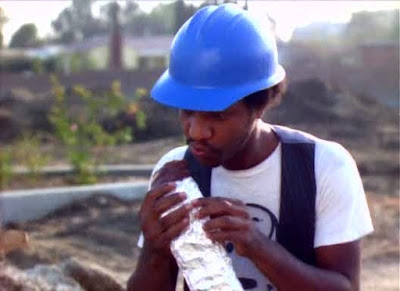
Donald’s co-workers agree that the meat is pretty good; by this point the film’s great fun. Watching Donald and his work-mates tucking into chunks of human flesh is beginning to give us something of what the film promised. Still not really a massacre though….
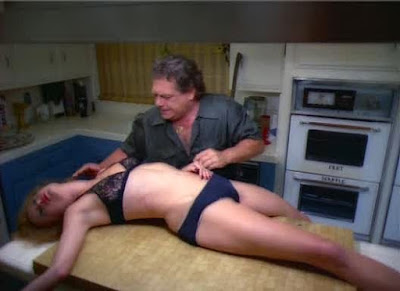
Oh wait, here we go! Running low on surplies and very conscious that his wife is rather tough as meat goes, Donald soon begins to solicit girls on the street and bring them home. Once there, they all seem a little puzzled by how little desire he shows for them. What they don’t realise until too late is that it’s not so much their bodies that Donald is interested in as their flesh! He chops, slices, dices and microwaves. Then shares it with his - now much friendlier - work-mates.

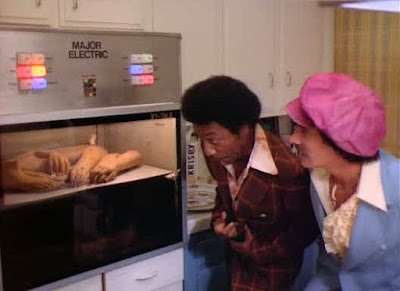
I shall leave the (slightly lacklustre) ending not entirely spoiled; although I think you know by now more or less what you’re in for.
It’s a fun film and, at 76 minutes, I’d recommend it unreservedly. Although a little slow to get going and boasting some astonishingly wooden acting, this film is a lot of fun - and be honest: you’re not going to let bad acting put you off low-budget campy horror are you? Sometimes, when watching decidedly low-brow, low-budget films there is a tendency to wonder “how did it ever seem a good idea to make this?”. By the end of Microwave Massacres though, I’m sure you’ll be wondering how it could ever seem like a good idea NOT to make this. Flawed, cheap and trashy, Microwave Massacres is a triumph of b-movie cinema.
The trailer here happily labels it the “worst horror film ever”!
(I tell a lie: it isn’t entirely out of print and is infact available from Anthem DVD in the USA, looks like there was never a Region 2 DVD though)
Murder Party

Murder Party. Has there ever been a film so perfectly summed up by it’s title? Apart from Underwater City of course. Oh, or Godzilla Vs. SpaceGodzilla. Or actually pretty much half of the films I watch….
Regardless, Murder Party is both described by and lives up to it’s title. And the tagline? “Everybody Dies”? Believe it.
The film has split it’s viewers. With IMDb boards claiming that it is both the best film of 2007 and the “worst movie I have ever seen”. I have to say I don’t understand the haters at all; this film is a work of genius. It’s well-thought out, darkly comic and really great fun. The only negative point I’d pick up on is that it’s perhaps not the best paced film of all time; more on that soon.
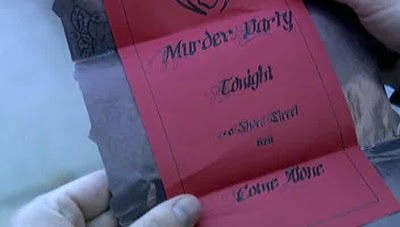
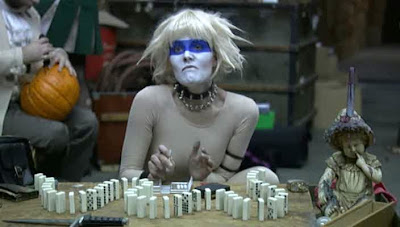
The premise is this: a handfull of achingly hip art-students have formed a plan. They, being so terribly avant-garde (darling) are going to break boundaries, smash taboos and cross lines like never before. Modern Art often sets out to shock or offend. Or both. These guys are going to smash previous efforts out of the water; they are planning to murder in the name of Art. To this end, they scatter invites to come alone to a “Murder Party” on Halloween, in the hope that some dumb lonely fool will take the bait and turn up. Needless to say, he does. Dressed as a Knight in carboard armour.
It’s all here: the characters are perfect larger-than-life stereotypes. From face-painted coke-snorting video-artist Lexi, through heavily side-burned Paul - ever reaching for his medium format camera - to Alexander, rich-kid art poser, giving pre-prepared pseudo-intellectual speeches.
The humour here is curious. Many of the complaints on IMDb are that “it was supposed to be funny and we didn’t laugh once in the whole film”. Well… I’m not sure if I laughed out loud once either, it’s just not that kind of funny - but it’s certainly not meant to be either. This is one of the only films where you could ever hear “paper-mache elements of a massive multi-media meta-structure” coupled with “staple a pancake to his face and push him infront of a train”. There’s slapstick, there’s violence, there’s perfectly pitched piss-taking of art-students (Lexi wants to film the murder and call it ‘Valediction in Black’, Alexander assures them that the hapless Knight’s death certificate will read ‘Art’ as cause of death). I might not have laughed out loud as I watched, but I didn’t stop grinning at all.
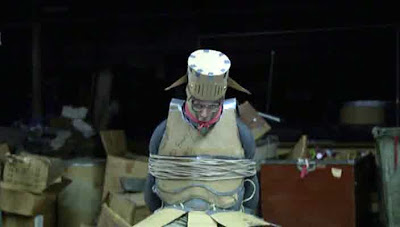
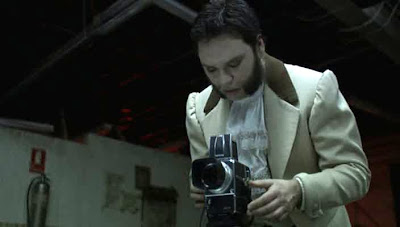
Now for the problem with the pacing. The film divides more or less into three sections. The setting up of the premise and the capture of the Brown Knight is never less than interesting. The end third is completely bonkers, with some brilliant bloodshed all over the place. But the middle third? The middle-third is undoubtedly the cleverest bit; the dialogue is pretty incredible, but never means a lot. They play an inspired game of ’truth or dare’, preceded by shooting up CIA-grade Truth Serum (supplied by ‘Zycho’ the Eastern-European (?) drug-dealer). The only shame is that the clever middle-third doesn’t amount to much in terms of plot; it creates the brilliantly realised characters, yes, but never really reaches its full potential, which is a shame.
But, despite any of these criticisms, the film is fantastic. Being low-budget should never be an excuse for a film’s failings but here we need no excuse. The budget here has been spent impeccably; almost never do they attempt to create an effect beyond their budget (though Macon’s burns would be debateable…), which is so often the failing of a low-budget film. No, this is a case of ambition kept carefully within budget and it is all the better for it.
I have tried to give almost nothing away about the end-segment, and I believe it’ll be all the better for it. This is by no means a perfect film, but it is definitely a very good film, a funny film, and a film that suggests good things for an inexperienced director’s career.
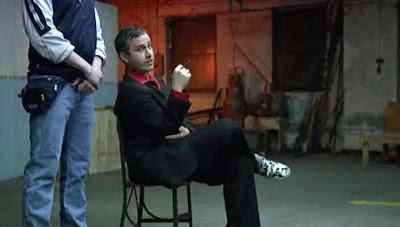
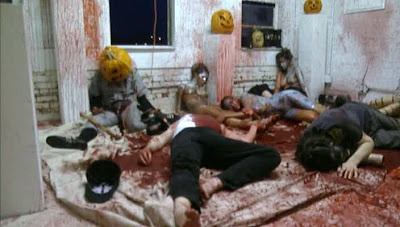
If I needed to say it again, the ending is totally awesome.
I would never normally advertise a DVD, but hey, this costs a fiver in the UK or just 8 bucks in the Us. It’s easily worth that much.
Trailer here:
No Man's Land: Rise of the Reeker
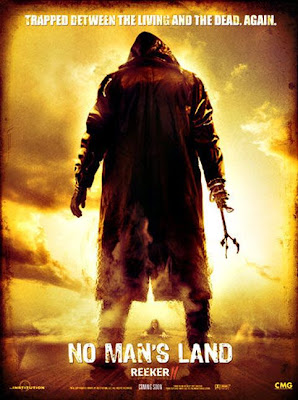
Stumbled across this fairly lame action/horror attempt on zone horror. Starts as a fairly tame sherriff vs. robbers film, turns into a fairly tame sherriff and robbers vs. monster film and then descends into a confusing ‘what-the-hell-just-happened?’ film. So not great then.
The only part that is truly wonderful is the sequence where the characters discover the invisible wall (yes, seriously…) that’s trapping them in this haunted little bit of desert. One guy plays out the full Parisian Street-mime repetoir, feeling the invisible wall, leaning on it, pressing his face against it and finally running headlong into it.
His performance is only bettered by the guy who drives his car head on into the invisible wall. Not only is it one of the better moments of the film but he also loses half his head doing it. Which has got to be good, no?
Last half-hour’s quite fun. The rest is pants.
Trailer here: